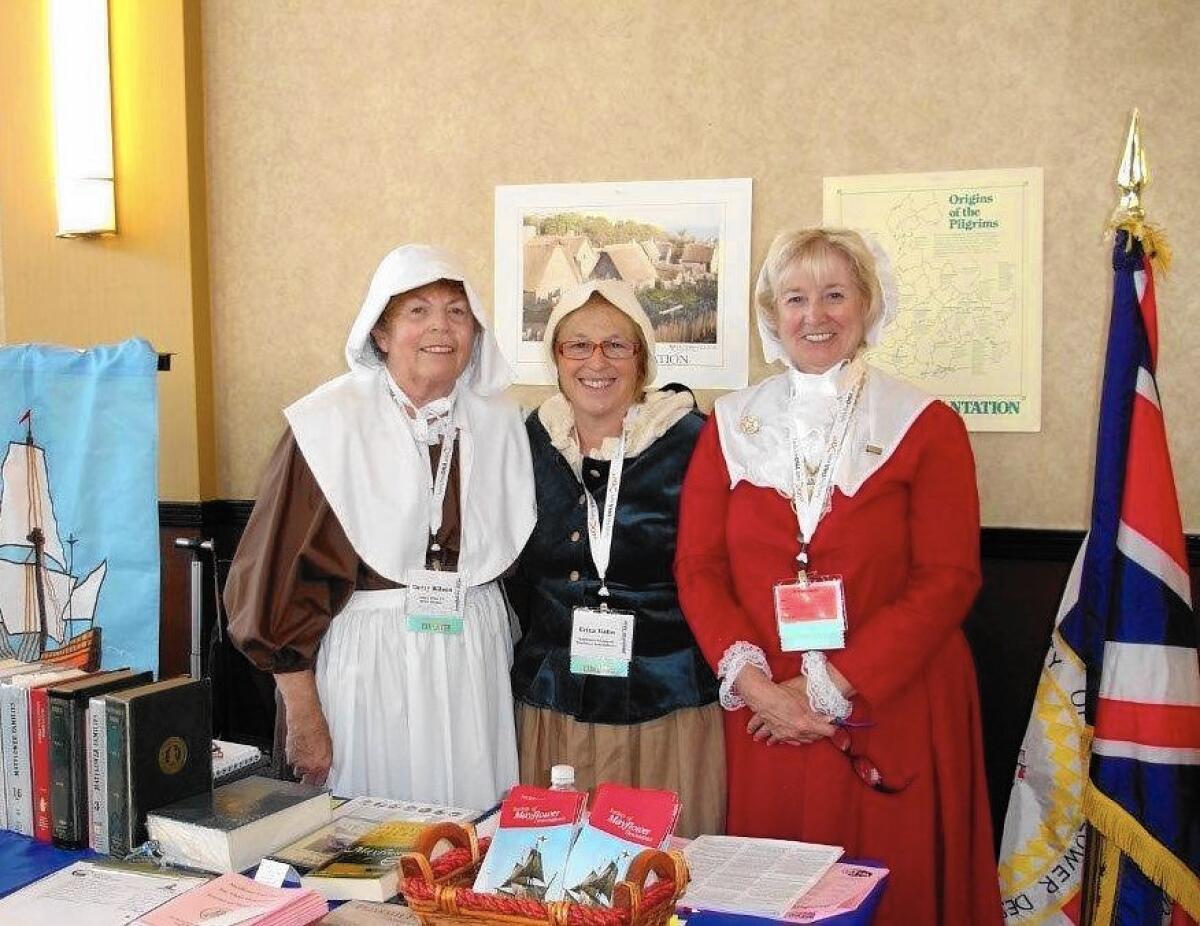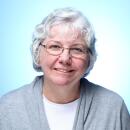Descendants give thanks for the pilgrims

- Share via
They set out from Southampton, England, in two ships that soon became one as the Speedwell began to spring leaks and its passengers had to be transferred to the other vessel.
The Mayflower then continued on to the New World with its 102 passengers, landing 65 days later in what is now known as Cape Cod, Mass. The area was not hospitable for farming, and so the pilgrims would soon make their way to the place that would become their home, present-day Plymouth, Mass.
Nearly 400 years later, their struggles to escape religious intolerance and create their own colony are being kept alive by a group of people who couldn’t be prouder of these adventurous souls, about half of whom died in the first year.
They are descendants of the travelers, a fact proven through painstaking documentation and final approval by the historian general of the General Society of Mayflower Descendants — based in Plymouth, Mass.
While Erica Hahn is quite enthusiastic about her lineage now, her genealogical journey got off to a slow start. Hahn is the governor of the Orange County Mayflower Colony, which was founded in 1974 as part of the 108-year-old California Society of Mayflower Descendants. The local group has 300 members, though only a few dozen are active participants.
“I think I was about 12 at the time and living in Cincinnati, Ohio, and used to go to my grandmother’s and had been assigned to read ‘The Courtship of Miles Standish,’” she said, referring to the narrative poem by Henry Wadsworth Longfellow. “And I am finding this so ridiculous that I said I don’t believe that these people even existed. And grandma looked down her aquiline nose at me and said, ‘Not only was Miles Standish real, he was your direct ancestor.’”
For many years, Hahn, who lives in Monrovia but joined the society while a resident of Huntington Beach, still wasn’t inspired to pursue her heritage. But, as so often happens, the older people get, the more they want to know where they came from.
In her search, Hahn originally “piggybacked” onto the 1913 membership of her grandfather’s mother, Clara Cole, who was a descendant of Mayflower passenger Richard Warren. That application was full of affidavits, including one written in 1892 by Clara’s uncle based on a letter he had from his 85-year-old aunt describing the 1832 wedding of his parents. No other record of this wedding exists anywhere, Hahn said.
Early New England is easy to research, Hahn said, because the towns “dutifully kept records of births, deaths, marriages.” But, she added, by the 19th century, records are sparse, and most Mayflower applications are pieced together with a variety of documents, such as the affidavits in Clara’s case.
It turns out that Hahn’s maternal grandmother, Helen Holmes, was also a Mayflower descendant through Helen’s great grandfather Southworth Holmes, who was born in Barnstable, Mass., in 1799 but immigrated to Cincinnati and is buried at Spring Grove Cemetery. Spring Grove put all of its burial records online several years ago, allowing Hahn to trace her grandmother to Southworth and bridge the 19th century.
To establish Southworth’s parentage, she was aided by a CD of vital records in Barnstable from the New England Historic Genealogical Society. His baptismal record and the Barnstable vital records confirmed that both of his parents were descended from the Mayflower.
In particular, his mother, Martha Samson, was listed in Barnstable vital records as the daughter of Southworth Samson and Jedida Paine, both of whom are in the society’s “silver books,” which represent the first five generations descended from the Mayflower.
“Once you get your line into a silver book, you are home free,” said Hahn, 69, who after spending a couple years on research was allowed to join the society in 2004.
Early New England is easy to research because, she said, all of the towns “dutifully kept records of births, deaths, marriages,” including affidavits — one written in 1892 quoting from a letter written to Southworth Holmes in 1892 by his 85-year-old aunt, who had been an eyewitness to the 1832 marriage of his parents. No other record of this marriage exists anywhere, she said. But by about 1750 to 1775 that ease comes to an end, she said.
Through her work she found that she was also descended from Mayflower passenger Richard Warren.
Multiple connections are not uncommon.
June Brainard Lazich, a society member who lives in Mission Viejo, said she has verified links to nine people who were on the historic vessel.
*
Tale of ‘strangers’ and ‘saints’
Aboard the Mayflower were two groups — the strangers and the saints, also known as separatists. The separatists had spent 11 years in Holland, where they fled first after illegally breaking from the Church of England. The blending with the strangers occurred when additional passengers were added in England by London investors for financial reasons.
The strangers may have had other motivations, but like the separatists they wanted a better life. If the colony was to survive, everyone would need to work together. So before anyone aboard the Mayflower departed the ship in Plymouth, it was decided that a governing document would be written.
On Nov. 11, 1620, the Mayflower Compact was signed. Many people believe it formed the basis for the U.S. Constitution.
What connects many members of the Orange County Mayflower Colony is their pride in what the pilgrims did to set the country on its path.
“These people are fundamental to who we are as Americans,” Hahn said.
Brainard Lazich likes to educate people who talk with particular reverence of Jamestown — America’s first permanent English colony, established 13 years before the pilgrims arrived.
The people of Jamestown had come to the New World seeking riches, while the founders of Plymouth had sought freedom from religious persecution and had intended to stay, not simply make their fortunes and leave.
“They came here to find gold,” Brainard Lazich said of the Jamestown founders. “The Mayflower came here to establish a place to live. That is a big difference. They started this country, so we are very proud to be in the Mayflower Society because of that.”
For member Marcia Maloney, the pilgrims played a key role in U.S. history.
“It was the starting of this country, the very beginning, and to think of the hardships they suffered to get here,” said Maloney, of Laguna Woods. “How scary is that? You want religious tolerance so much that you leave the security of the family nest and embark in this voyage to who knows where.”
*
Echoes of the first Thanksgiving
The pilgrims soon ran short of fresh food on their voyage, leading to cases of scurvy. But within a year after their landing, they would be celebrating what is thought of as the nation’s first Thanksgiving. Having developed a relationship with the Wampanoag Indians, who taught the newcomers how to plant corn, the pilgrims joined the native people in a days-long feast of, say historians, fowl, fish, corn and venison.
This past Saturday, the Orange County colony was to have held its annual Compact Day celebration, with the more lavish traditional turkey dinner of today. Its setting was also an upgrade from the first Thanksgiving — the Courtyard by Marriott in Santa Ana.
While its gatherings offer camaraderie and guests who might speak about relevant topics like colonial history or genealogy, the society is primarily interested in promoting education.
“One of my passions is how do we get young people involved, interested in history,” said Scott Miller, a Westminster resident who, at 52, is among the youngest of the society members, locally and nationally. “Frankly, Massachusetts is far away, like “Star Wars,” a galaxy far, far away. So how do you make them interested? Because history is taught almost as dates and places, but it is about people.”
Walter Powell, the executive director of the national General Society of Mayflower Descendants, shares the same concern. It can be hard to get the younger generations interested in heritage, he said.
The national group was founded in 1897 and has 52 member societies — in 50 states as well as the District of Columbia and Canada. All are independent with their own officers.
Arlene Leedy, 78, of Dana Point, says part of the fun of being a member is going to schools and sharing with students “exactly what a pilgrim is, what it means.”
“It’s not just a celebration with the Indians,” said Leedy, who heads the group’s scholarship committee.
Brainard Lazich, 84, also liked to visit schools — dressed up as Priscilla Mullens, who married fellow colonist John Alden in Plymouth in 1621.
“Kids would say, ‘Here’s the pilgrim lady,’” she recalled.
Sign up for The Wild
We’ll help you find the best places to hike, bike and run, as well as the perfect silent spots for meditation and yoga.
You may occasionally receive promotional content from the Los Angeles Times.




